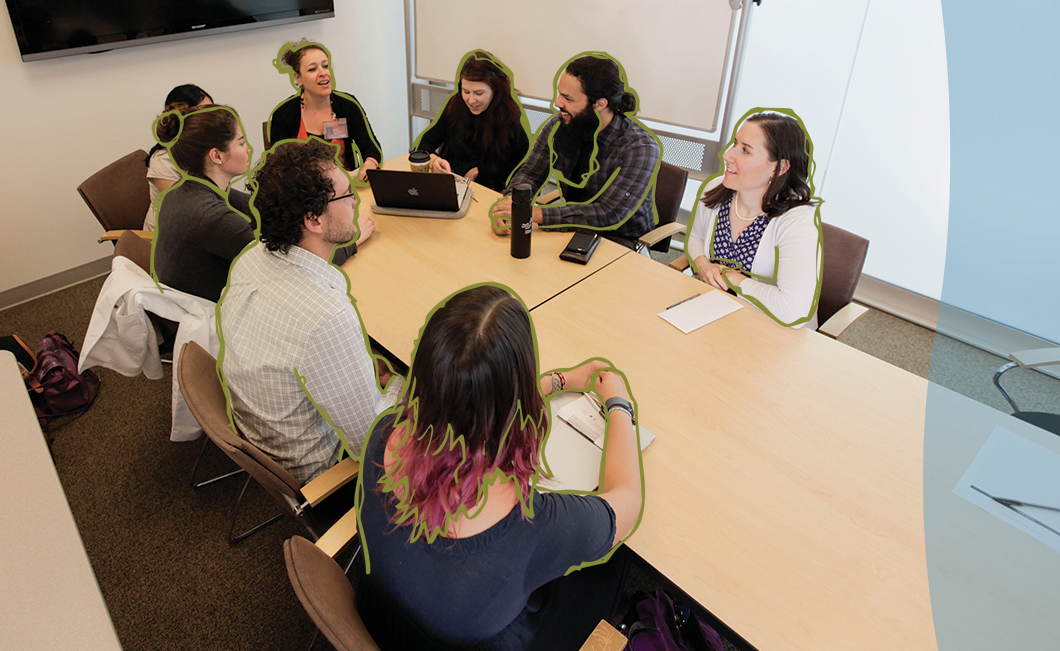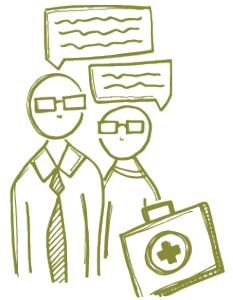Transforming Care

The patient is a 28-year-old female.
She complains of fatigue, nausea, dizziness. Her heart races.
She’s prone to self-diagnosis online and to ER visits.
Diabetes may explain some of her symptoms; sleep apnea, others.
But the issue may not be completely physical.
“There’s some drug abuse in the past. She ran away at 16. There’s some stuff,” an attending physician tells a group of other providers at the Pacific University Psychology & Comprehensive Healthcare Clinics. “We’ve talked about offering a counselor to help her organize her thoughts, or occupational therapy to help her in school. And if insurance covers it, she may be more open to it."
“Our goal is to keep her out of the emergency room.”
Healthcare providers at Pacific’s two comprehensive healthcare clinics are having the conversations you wish your doctors could have.
What else might be causing that symptom? Could it be organic? Psychological?
Wait, she’s also being treated for another condition. Could they
be related?Does insurance cover that test? Is there a way we could lower his costs?
The Psychology & Comprehensive Healthcare Clinics are the outgrowth of Pacific’s previous psychology clinics. Today, though, Pacific’s School of Professional Psychology partners with other health professions programs at Pacific, such as occupational therapy, physical therapy and speech-language pathology, as well as the nearby National College of Natural Medicine, whose students and faculty provide comprehensive healthcare services.
Students, interns and licensed providers on the faculty offer a full suite of care for low-income patients. They meet weekly to discuss their cases collectively, seeking insight from one another and referring patients back and forth for integrated and complementary care.
It’s a system designed to model a new way of doing business in healthcare — one that brings providers together across the spectrum of professions to treat the patient as a whole person.

Experts, such as the World Health Organization, have long advocated such interprofessional practice — but it’s not easy to implement within established industry structures.
That’s why leaders at Pacific University think it’s so important to make it work in small clinics and university settings.
Sue Stein is the Associate Dean of the Pacific University College of Health Professions, and former dean of the School of Pharmacy. She also holds the title of director of Pacific’s Program of Interprofessional Practice, Education and Research.
Pacific, she said, has already made moves to support interprofessional practice and education. Her role is to pull all of the ideas and programs together strategically.
“Pacific is so far ahead,” she said, citing even the creation of the College of Health Professions in 2004 and the construction of the Hillsboro Campus in 2006.
But true interprofessional education isn’t just about being co-located; it requires two or more professions to unite for purposeful, patient-driven outcomes.

“Look at all the professions under one roof,” she said.
Most universities with a variety of healthcare programs spread them out, medical school over here, nursing school over there. Putting many of Pacific’s programs in one place has fostered a community of collaboration, she said.
"But true interprofessional education isn’t just about being co-located; it requires two or more professions to unite for purposeful, patient-driven outcomes."
At Pacific, that’s taken several forms. All students in the College of Health Professions take part in interprofessional case conferences, working in small interprofessional teams to examine a specific case and identify opportunities for collaboration. They also take part in an interprofessional competency course, working with a team of fellow students to address a problem or need interprofessionally.
Nowhere is Pacific’s interprofessional focus more apparent than in its clinical experiences.
At the Interprofessional Diabetes Clinic, the woman with glaucoma has become something of a legend. The clinic has brought together faculty and students from optometry, dental hygiene, occupational therapy, physical therapy, physician assistant studies, pharmacy, and professional psychology to provide patients with one-stop care for their diabetes-related conditions.
As the story goes, a woman going through her morning of back-to-back appointments was given eye drops to treat her glaucoma. Later, though, the physical therapy team realized she suffered severe arthritis and would be unable to squeeze the eye-drop bottle.
The problem was easily remedied, but only because it was recognized through the cooperation of an interprofessional team.
“They all hear the full story of a patient,” said Carole Timpone, associate dean of clinical programs in the Pacific University College of Optometry. “Suddenly you understand why the patient doesn’t take his meds: He’s just out of a job.
“Maybe he doesn’t tell the first person he sees, but he might tell the third. He has to choose to pay for meds or food for his kids. It’s so powerful when it comes out.”
Those same kinds of stories crop up again and again, at the IDC, or Pacific’s new Interprofessional Balance & Dizziness Clinic, at the Psychology & Comprehensive Healthcare Clinic or in numerous workshops linking speech-language pathology with other professions.
It’s those experiences that bring health professions students today to Pacific University — and that inspire them to seek out opportunities to advance interprofessional practice as alumni.
Malea Johnson DHS ’14 took part in an interprofessional travel course to Nicaragua with the College of Health Professions during her time at Pacific.
Students and faculty from occupational and physical therapy, dental hygiene, and physician assistant studies worked together to care for elders in hogars, or homes, in the Central American country and to provide training for permanent staff members at the centers.
The focus on interprofessional practice is part of what drew Johnson to Pacific University’s bachelor program in dental hygiene, and it’s helped shape her career.
“I was really impressed with (Pacific’s) interprofessional program, and hearing how passionate all the faculty were and how dedicated they were, I knew there was nowhere else I wanted to go,” Johnson said.
Today, Johnson is the first dental hygienist to work as part of the interprofessional team treating patients through the Northwest Colorado Visiting Nurses Association’s rural clinics.
“Going on the Nicaragua trip, the (interprofessional competency course), the Interprofessional Diabetes Clinic, made me confident in sharing with other professions,” she said. “That’s a confidence I wouldn’t have had if I’d gone to school anywhere else.” ■
About This Issue
At Pacific University, out alumni are a diverse group. About half of our 25,000-plus alumni graduated in just the last 15 years, many from our graduate and professional programs. More than anything, this publication is for you.
Though your education had the Pacific hallmarks of a caring, nurturing faculty in a small learning environment, your experience was still fundamentally different than the four years that most undergraduates spent in Forest Grove.
This special edition of Pacific magazine is an effort to highlight your experiences and to provide you with additional support as you navigate your professional world. We hope you enjoy it. We would love to hear your thoughts on this publication, and how we can better tell your story and support you as alumni of Pacific University.
This story first appeared in the Spring 2016, Special Healthcare issue of Pacific Magazine. For more stories, visit pacificu.edu/magazine.


